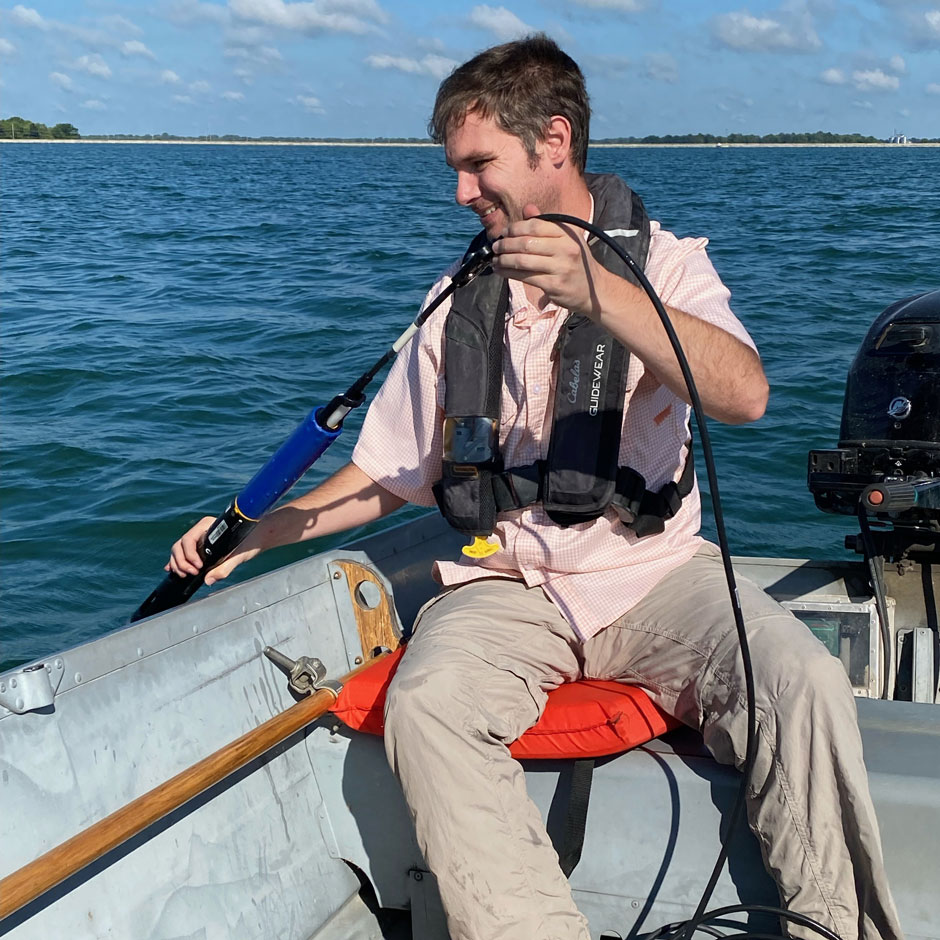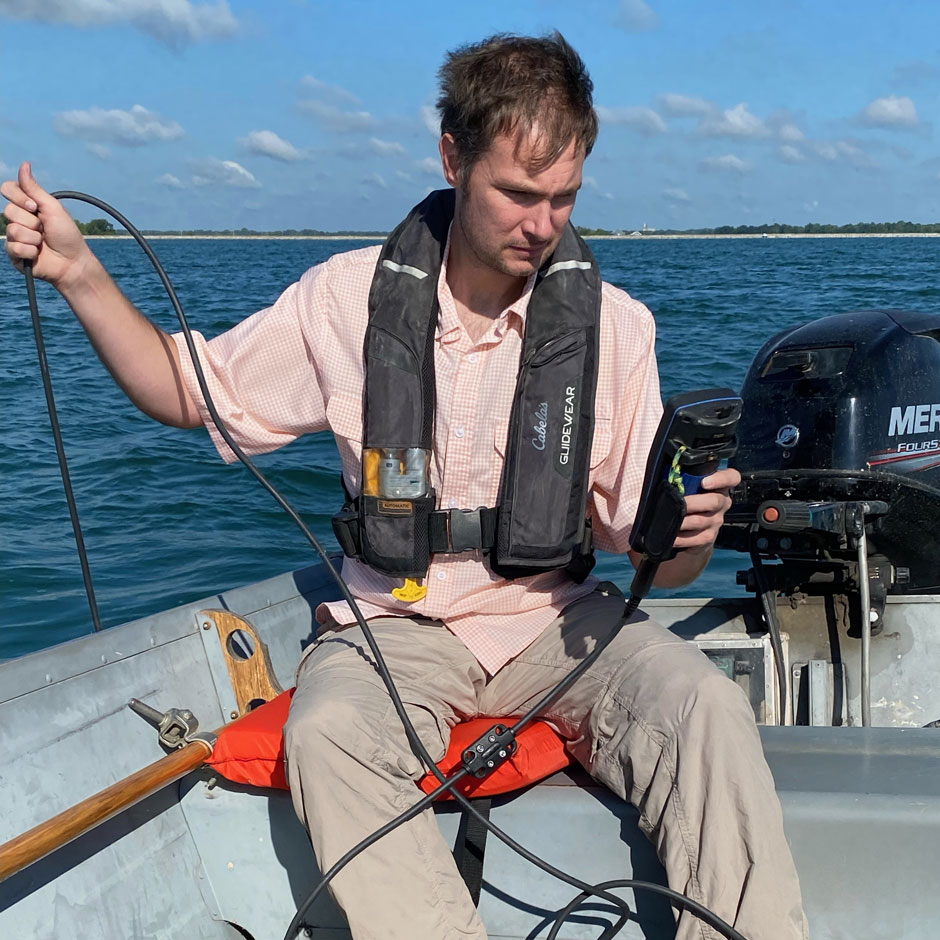From the Tap: Source Water Monitoring for Public Health
 A water research analyst prepares an EXO1 Sonde for spot sampling. (Michael Bahler / City of Columbus Division of Water)
A water research analyst prepares an EXO1 Sonde for spot sampling. (Michael Bahler / City of Columbus Division of Water)In regions with historically secure access to clean drinking water, few think about the work that goes into ensuring that the water they fill their cups with is safe. In reality, millions of dollars are invested in the infrastructure, equipment and teams involved in converting source water into drinking water.
While all the work that goes into providing clean water often goes unnoticed, analysts like Michele Gilkerson, a water research analyst with the City of Columbus Division of Water, know exactly how much goes into securing safe water for millions of people.
Gilkerson started with Battelle Memorial Institute in 1991 in their water ecology section. There, she saw how interesting source water monitoring could be, even though it isn’t often spotlighted in the environmental sector. “When I started college, I thought I was going to either go to pharmacy school or medical school—I really didn’t have a path. At 18, you’re kind of too young to decide what you want to do with the rest of your life,” she explains.
Working with Battelle helped her realize she could use her biology and chemistry background to study water. “This job wasn’t something I set out to do—I just kind of fell into it and developed a love for it.”
Why Monitor Source Water?
Converting unclean source water to potable water takes hours of labor that begins with monitoring the source water to prepare treatment plants for incoming water quality. The City of Columbus Division of Water has four branches, and Gilkerson supervises the water quality research section. Her team provides system surveillance of the watershed—essentially monitoring the bodies feeding the water treatment reservoirs.
The city currently has two surface water plants and one groundwater plant that are used to treat source water and convert it into drinking water. The Dublin Road water plant is particularly impacted by nitrate and phosphorous loading resulting from agricultural runoff though there are also chemical pollutants and harmful algal blooms that can impact source water.
Gilkerson’s group is responsible for collecting samples to test for nitrate and phosphorous, monitoring harmful algal blooms and sampling for Atrazine. The chemical was a major concern in the 90s when pesticides were used in higher quantities. Gilkerson elaborates, “Atrazine used to be a big concern of ours, but not so much anymore. The farmers really have a handle on what they put on the ground now.”
Monitoring source water is important to ensuring that the plants are prepared to handle whatever the source water contains, as well as getting ahead of potential taste and odor problems resulting from contaminated source water.
Nitrate and phosphorous monitoring are particularly important for the region as source water is often exposed to nutrient loading, and surpluses can lead to increases in algal blooms, some of which are comprised of harmful cyanobacteria. Gilkerson uses a host of sensors and real-time data technology to monitor the surrounding source waters and provide insight into incoming conditions. “We’re kind of their eyes,” states Gilkerson.
The insight is valuable to the treatment facilities that spend millions of dollars improving water treatment processes. For example, the city invested $40 million to build an ion exchange building at the Dublin Road water plant, which can help treat the water in case of a nitrate event.
Something that may need to be used soon as a nitrate event has been observed upstream, thanks to the real-time systems deployed throughout the watershed. Fortunately, the nitrate has yet to be found in the reservoir, but the systems will alert the team if it does appear.
Gilkerson explains, “Somewhere, somehow, the nitrate is being either assimilated by vegetation or impounded there—we just haven’t seen it yet. But we’re aware—we’re not going to be caught not being able to turn on the ion exchange and having another maximum contaminant level (MCL) violation where we have to issue a public notification for nitrate exceedance.”
How to Monitor Source Water
The Division of Water ensures that drinking water meets all compliance standards for its 1.3 million customers who rely on the city to provide clean drinking water. Gilkerson’s group supports the city’s mission by providing real-time data and manual sampling that help ensure drinking water quality.
The water isn’t sterile—it’s disinfected, meaning that poor source water quality can influence the taste, odor and, potentially, the safety of tap water. “For us, it’s public health. We’re not under that umbrella, but it really is a public health service that we do—we ensure that the potable water meets the Safe Drinking Water Act standards for the people who rely on public water,” summarizes Gilkerson.

(Michael Bahler / City of Columbus Division of Water)
In terms of real-time data, Gilkerson’s team uses floating stations equipped with sensors and NexSens data loggers to collect and transfer data from more remote sites to the WQData LIVE database. There are currently eight sites that work on the NexSens platform, with a majority of the stations switching to newer equipment like the YSI EXO sondes.
The division also collects physical samples that are analyzed in the lab, monitoring for more specific contaminants like perfluorinated alkylated substances (PFAS), which the EPA recommends having a value as low as four parts per trillion.
The changing requirements are one of the primary challenges to monitoring drinking water, as these recommendations can introduce a variety of issues regarding access to equipment and the ability to meet standards quickly. While PFAS can be treated through powder-activated carbon (PAC), the high demand for the product may introduce cost and supply issues as the recommendation is enforced throughout the U.S.
Another problem the city faced for many years was the inability to paint a complete picture of the watershed over time. Grab sampling provided insight into the health of the water at the moment of sampling but failed to capture what the watershed experienced outside of that period.
In 2004, Gilkerson’s department switched to the NexSens platform. They started with a floating platform deployed at the Hoover reservoir, equipped with a YSI winch that profiles water quality from the top to the bottom. The gathered data is logged and then transferred by the NexSens logger to the WQData LIVE database for easy storage and remote monitoring potential.
“It takes readings every 15 minutes and it downloads every hour. So we get a really good snapshot,” explains Gilkerson. The success of the Hoover platform led to the city’s current initiative to construct another in the O’Shaughnessy reservoir, which feeds into the Dublin Road plant and a future fourth plant. “It all comes back through the modem cell phone technology. It’s amazing! [. . .] So that has been phenomenal because that has engineered out a challenge that we used to have,” she continues.
Gilkerson still uses a combination of real-time and discrete sampling to assess water quality. A Doppler sonar is used to measure water volume, as reservoir levels are not always fixed. Profiling equipment like the YSI winch paired with NexSens data loggers work together to gather and transfer data on the entire water column. Similarly, Gilkerson uses a YSI EXO1 Sonde from a boat to measure water quality at multiple points in the water column.
Real-time profiling equipment is particularly important in discharge areas where effluents from the plants may impact wildlife. “With the ion exchange, we needed it to be a profiling location because of the brine and the salt. We have to know where that salt is and where it’s staying. So when we go to discharge, we’re not going to kill any fish in the stream,” explains Gilkerson.
The combined approach also makes the data gathered easier to interpret. Data from the sondes are downloaded and then examined for trends alongside the real-time data housed on WQData LIVE. Dissolved oxygen, pH and conductivity are the three most significant parameters, particularly conductivity, as it is easily influenced by salty runoff and can lead to salty-tasting water.
Making Real-Time Data Accessible
The remote capabilities enabled by NexSens have changed the way Columbus monitors its source water. Fondriest and NexSens were both integral parts of this change and worked alongside Gilkerson to create the platforms she currently relies on. The team continues to provide technical support for troubleshooting and guidance when problems arise. “I really do like the support and the rapport that we have with Fondriest Environmental and NexSens Technology,” states Gilkerson.
As a municipality, the data gathered by Gilkerson’s team needs to be protected, and WQData LIVE provides that security. Gilkerson explains that the addition and ease of the database have been a considerable advantage for the group in the last 25 years that she’s worked for the city. “I can log on and see all my stations [. . .], and there’s nobody else doing this. So that’s really helped us a lot, and our director and administrators are able to get on and see all of this data,” explains Gilkerson.
The success of the project can inspire other water treatment facilities to integrate new technology and approaches. “It helps other utilities and wastewater folks [. . .]. We’re all in this together. And so things that Fondriest and NexSens are doing, I believe, are really instrumental in helping the water utilities industry and professionals,” states Gilkerson.




0 comments